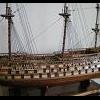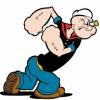HOLIDAY DONATION DRIVE - SUPPORT MSW - DO YOUR PART TO KEEP THIS GREAT FORUM GOING! (Only 13 donations so far - C'mon guys!)
×
-
Posts
1,280 -
Joined
-
Last visited
Reputation Activity
-
 AnobiumPunctatum reacted to RGL in USS Langley by RGL - FINISHED - Trumpeter - 1/350 - PLASTIC
AnobiumPunctatum reacted to RGL in USS Langley by RGL - FINISHED - Trumpeter - 1/350 - PLASTIC
So the metal latticework I painted upside down because the flat bits on top will seat the flight deck, but it means the whole tiny needs a respray.
-
 AnobiumPunctatum got a reaction from Archi in Winchelsea Nef 1274 A.D. by Louie da fly - FINISHED - 1:75
AnobiumPunctatum got a reaction from Archi in Winchelsea Nef 1274 A.D. by Louie da fly - FINISHED - 1:75
I think I can give you some information about this drawing,. This is a reconstruction drawing of Skuldelev I from 1971.
It was as far as I know the base for the presentation of the ship in the musuem. I own a copy of this but there are in the meantime some newer reconstructions which are giving a slightly different hull. But you can build a very nice model with this information.
I am searching a reconstruction of the Haithabu knarr and longship. I hoppe to find someday one good drawing. of the find
-
 AnobiumPunctatum got a reaction from FrankWouts in HMS Winchelsea 1764 by Trussben - FINISHED - 1:48
AnobiumPunctatum got a reaction from FrankWouts in HMS Winchelsea 1764 by Trussben - FINISHED - 1:48
A really informative buildlog, Ben. I like your idea, to show some dummy frames.
-

-
 AnobiumPunctatum reacted to RGL in USS Langley by RGL - FINISHED - Trumpeter - 1/350 - PLASTIC
AnobiumPunctatum reacted to RGL in USS Langley by RGL - FINISHED - Trumpeter - 1/350 - PLASTIC
So another layer of green oil wash, still really shiny, will really attack it tomorrow. I’ll pulled off the masking tape to attack the boot strap as well.
Oh, it’s too green?
-
 AnobiumPunctatum got a reaction from druxey in Winchelsea Nef 1274 A.D. by Louie da fly - FINISHED - 1:75
AnobiumPunctatum got a reaction from druxey in Winchelsea Nef 1274 A.D. by Louie da fly - FINISHED - 1:75
I think I can give you some information about this drawing,. This is a reconstruction drawing of Skuldelev I from 1971.
It was as far as I know the base for the presentation of the ship in the musuem. I own a copy of this but there are in the meantime some newer reconstructions which are giving a slightly different hull. But you can build a very nice model with this information.
I am searching a reconstruction of the Haithabu knarr and longship. I hoppe to find someday one good drawing. of the find
-
 AnobiumPunctatum got a reaction from mtaylor in Winchelsea Nef 1274 A.D. by Louie da fly - FINISHED - 1:75
AnobiumPunctatum got a reaction from mtaylor in Winchelsea Nef 1274 A.D. by Louie da fly - FINISHED - 1:75
I think I can give you some information about this drawing,. This is a reconstruction drawing of Skuldelev I from 1971.
It was as far as I know the base for the presentation of the ship in the musuem. I own a copy of this but there are in the meantime some newer reconstructions which are giving a slightly different hull. But you can build a very nice model with this information.
I am searching a reconstruction of the Haithabu knarr and longship. I hoppe to find someday one good drawing. of the find
-
 AnobiumPunctatum got a reaction from Chuck Seiler in Winchelsea Nef 1274 A.D. by Louie da fly - FINISHED - 1:75
AnobiumPunctatum got a reaction from Chuck Seiler in Winchelsea Nef 1274 A.D. by Louie da fly - FINISHED - 1:75
I think I can give you some information about this drawing,. This is a reconstruction drawing of Skuldelev I from 1971.
It was as far as I know the base for the presentation of the ship in the musuem. I own a copy of this but there are in the meantime some newer reconstructions which are giving a slightly different hull. But you can build a very nice model with this information.
I am searching a reconstruction of the Haithabu knarr and longship. I hoppe to find someday one good drawing. of the find
-
 AnobiumPunctatum reacted to RGL in USS Langley by RGL - FINISHED - Trumpeter - 1/350 - PLASTIC
AnobiumPunctatum reacted to RGL in USS Langley by RGL - FINISHED - Trumpeter - 1/350 - PLASTIC
And a light coat of pink to represent faded red paint
-
 AnobiumPunctatum reacted to RGL in USS Langley by RGL - FINISHED - Trumpeter - 1/350 - PLASTIC
AnobiumPunctatum reacted to RGL in USS Langley by RGL - FINISHED - Trumpeter - 1/350 - PLASTIC
Alge part 1, mr Surfacer 1000 patted on with sponge. I reckon if I let this dry then do a few more layers I’ll get there .
-
 AnobiumPunctatum got a reaction from Cirdan in Winchelsea Nef 1274 A.D. by Louie da fly - FINISHED - 1:75
AnobiumPunctatum got a reaction from Cirdan in Winchelsea Nef 1274 A.D. by Louie da fly - FINISHED - 1:75
Chuck ,
You could not interpret this really precies from the seals. It could also mean that the shipside is lower. Have a look at the people how big they are.
You can develop a possible hull design, which will be mostly the same for every seal. Than you can add the specific detail. Where do you find the right dimensions of such a ship? You choose the big knarrs of the vikings. There are a lot of new findings you can use for the length as basic for such a ship.
If they will find a shipwreck of a nef such as the cog of Bremen, we have to learn everything new.
-
 AnobiumPunctatum got a reaction from Cirdan in Winchelsea Nef 1274 A.D. by Louie da fly - FINISHED - 1:75
AnobiumPunctatum got a reaction from Cirdan in Winchelsea Nef 1274 A.D. by Louie da fly - FINISHED - 1:75
I found time to take some pictures of the model and the lines of the reconstruction from Zimmermann. Hope the pictures are helpful.
-
 AnobiumPunctatum got a reaction from Cirdan in Winchelsea Nef 1274 A.D. by Louie da fly - FINISHED - 1:75
AnobiumPunctatum got a reaction from Cirdan in Winchelsea Nef 1274 A.D. by Louie da fly - FINISHED - 1:75
Hi Steven,
the model, you show the picture, is not build following the drawings from Zimmermann. The sources for this model are from Jochen v. Fricks "Normannenschiffe", Delius Klasing Verlag. The original book was first published in the GDR but I don't have information when.
Here is a link to the website, where the model was published and where I found the Information about the source.
If I remember right, Zimmermann shows an other castle. In the weekend I will have a look if I can scan you two fotos from the model Zimmermann has built.
I am really interested to yee your progress.
-
 AnobiumPunctatum got a reaction from Cirdan in Winchelsea Nef 1274 A.D. by Louie da fly - FINISHED - 1:75
AnobiumPunctatum got a reaction from Cirdan in Winchelsea Nef 1274 A.D. by Louie da fly - FINISHED - 1:75
Hi,
there is a really nice book and planset about this kind of ships: Werner Zimmermann "Nef de Cinque Ports". Another good information is the drawing in Landström.
-

-
 AnobiumPunctatum reacted to Louie da fly in Winchelsea Nef 1274 A.D. by Louie da fly - FINISHED - 1:75
AnobiumPunctatum reacted to Louie da fly in Winchelsea Nef 1274 A.D. by Louie da fly - FINISHED - 1:75
I've drawn the lines of the planks on the plug, basically using the technique outlined in the planking tutorials. And at the top you can see the wood I'm going to be using for the planking. Walnut from the dead tree of the guy next door, cut into sheets by the guy across the road. It's nice having good neighbours.
And covered it in cling-wrap so the planks don't get glued to the plug.
I used packing tape to hold the clingwrap close to the plug, and to keep the keel and stem and sternposts in place.
And I've started carving the first trumpeter.
Steven
-
 AnobiumPunctatum reacted to KrisWood in Oseberg Ship by KrisWood - 1:25 - Vibeke Bischoff Plans
AnobiumPunctatum reacted to KrisWood in Oseberg Ship by KrisWood - 1:25 - Vibeke Bischoff Plans
I rely entirely upon Google Translate and what little I remember of taking German in highschool (a good portion of the Danish words that Google mistranslates are similar enough to German that I can read them). 😆
Fortunately, this latest report has a glossary of Nordic shipbuilding terms in it that is a bit easier for Google to translate. 🙂
-
 AnobiumPunctatum got a reaction from BLACK VIKING in Oseberg Ship by KrisWood - 1:25 - Vibeke Bischoff Plans
AnobiumPunctatum got a reaction from BLACK VIKING in Oseberg Ship by KrisWood - 1:25 - Vibeke Bischoff Plans
Thanks for sharing this find. You can be very happy that you can understand what Wiebke writes. I have to use a translator
-
 AnobiumPunctatum got a reaction from mtaylor in Winchelsea Nef 1274 A.D. by Louie da fly - FINISHED - 1:75
AnobiumPunctatum got a reaction from mtaylor in Winchelsea Nef 1274 A.D. by Louie da fly - FINISHED - 1:75
Chuck I didn't read the book for a long time, as far as I remember right, the drawings are showing a prototype for a nef. For a specific model you have to refer to the seals. If you need help by understanding a sentence ask me. For reading the book you can use deepl.com. It's a really good translation program.
-
 AnobiumPunctatum got a reaction from mtaylor in Oseberg Ship by KrisWood - 1:25 - Vibeke Bischoff Plans
AnobiumPunctatum got a reaction from mtaylor in Oseberg Ship by KrisWood - 1:25 - Vibeke Bischoff Plans
Thanks for sharing this find. You can be very happy that you can understand what Wiebke writes. I have to use a translator
-
 AnobiumPunctatum reacted to Chuck Seiler in Winchelsea Nef 1274 A.D. by Louie da fly - FINISHED - 1:75
AnobiumPunctatum reacted to Chuck Seiler in Winchelsea Nef 1274 A.D. by Louie da fly - FINISHED - 1:75
Christian,
On pages 23-27 he has 14 different seals; Santander, La Rochelle, Dunwich, Romney, Southampton, San Sebastian, Pevesey, Hastings, Rye, Hythe, Yarmouth, Dover, Nieuport and Faversham. He has Winchelsea and Sandwich prominently displayed elsewhere. On pages 105 thru 111 he has the diagrams I mentioned of all but the first 2.
Steven,
I think you made a good choice. As you mentioned previously, Winnie is one of the more artistic seals and it is very clearly rendered.
-
 AnobiumPunctatum got a reaction from Chuck Seiler in Winchelsea Nef 1274 A.D. by Louie da fly - FINISHED - 1:75
AnobiumPunctatum got a reaction from Chuck Seiler in Winchelsea Nef 1274 A.D. by Louie da fly - FINISHED - 1:75
Chuck I didn't read the book for a long time, as far as I remember right, the drawings are showing a prototype for a nef. For a specific model you have to refer to the seals. If you need help by understanding a sentence ask me. For reading the book you can use deepl.com. It's a really good translation program.
-
 AnobiumPunctatum reacted to KrisWood in Oseberg Ship by KrisWood - 1:25 - Vibeke Bischoff Plans
AnobiumPunctatum reacted to KrisWood in Oseberg Ship by KrisWood - 1:25 - Vibeke Bischoff Plans
Before my last post the other day, I'd been quiet for a long time. Several months ago my laptop died and so I was no longer able to work on my project. Around the same time I had to get a second job to keep up with the bills, so I didn't have time for projects anyway. On the bright side, the second job meant I finally had enough money to buy a new laptop.
Reading the two volume reconstruction report by Ms Bischoff has inspired me to get back into my project. Having read the report and reviewed the plans, I see now that I got several things wrong and I'm going to need to start over, this time doing it entirely by the numbers instead of by eye. I've already started on the keel using the new dimensions. It's much easier to plot out the T shape now that I have the numbers for sections I'd been missing before and guessing at by eye, and I can already tell it's not going to be as fragile as it was before.
Meanwhile I still have very little time (due to the two jobs and all). Does anyone want to collaborate on plugging in the numbers from the report above into Rhino?
-
 AnobiumPunctatum reacted to RGL in USS Langley by RGL - FINISHED - Trumpeter - 1/350 - PLASTIC
AnobiumPunctatum reacted to RGL in USS Langley by RGL - FINISHED - Trumpeter - 1/350 - PLASTIC
Rattle can red primer!
-
 AnobiumPunctatum got a reaction from popeye the sailor in USS Langley by RGL - FINISHED - Trumpeter - 1/350 - PLASTIC
AnobiumPunctatum got a reaction from popeye the sailor in USS Langley by RGL - FINISHED - Trumpeter - 1/350 - PLASTIC
The PE parts are looking fantastic.







a.thumb.jpg.0d220a67a0520c621b587b05b51dcd99.jpg)

